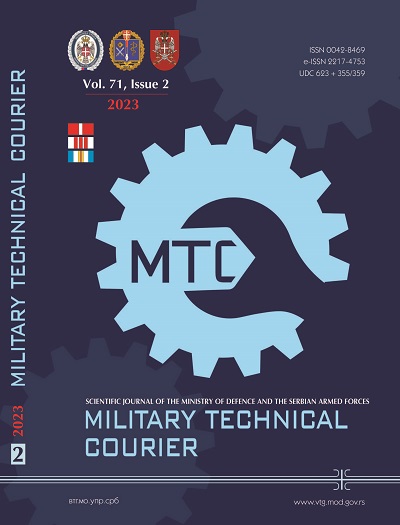Mathematical modeling and simulation of a rectangular pulse transceiver operating in the discrete-time domain
Abstract
Introduction/purpose: The paper presents the theory and design issues of a discrete-time communication system used for discrete-time pulse transmission with and without filtering. Signals are analyzed in both the time domain and the frequency domain.
Methods: The system is theoretically analyzed using block schematics expressed in terms of mathematic operators and the system simulation is performed to confirm the theoretical findings.
Results: Discrete-time signals are presented in the time domain and the frequency domain as well as confirmed by a simulation designed in Matlab.
Conclusion: The results of the paper contribute to the theoretical modeling and design of modern discrete communication systems.
References
Abramowitz, M. & Stegun, I.A. 1972. Handbook of Mathematical Functions with Formulas, Graphs, and Mathematical Tables. Washington, D.C.: United States Department Of Commerce, National Bureau of Standards, Applied Mathematics Series – 55 [online]. Available at: https://personal.math.ubc.ca/~cbm/aands/frameindex.htm [Accessed: 20 January 2023].
Benvenuto, N., Corvaja, R., Erseghe, T. & Laurenti, N. 2007. Communication Systems, Fundamentals and Design Methods. Hoboken, NJ, USA: John Wiley & Sons, Inc. ISBN-13: 978-0470018224.
Berber, S. 2009. Deterministic and Stochastic Signal Processing: Continuous and Discrete-time Signals. VDM Verlag Dr. Müller. ISBN-13: 978-3639111880.
Berber, S. 2019. Discrete time domain analysis of chaos-based wireless communication systems with imperfect sequence synchronization. Signal Processing, 154, pp.198-206. Available at: https://doi.org/10.1016/j.sigpro.2018.09.010.
Berber, S. 2021. Discrete Communication Systems. Oxford, UK: Oxford University Press. ISBN-13: 978-0198860792.
Cavicchi, T.J. 2000. Digital Signal Processing, Solutions Manual. Hoboken, NJ, USA: John Wiley & Sons, Inc. [Accessed: 20 January 2023].
Haykin, S. 2001. Digital Communication Systems, 4th edition. Hoboken, NJ, USA: John Wiley & Sons, Inc. ISBN: 0-471-17869-1.
Ingle, V.K. & Proakis, J.G. 2012. Digital signal processing using MATLAB, 3rd edition. Stamford, CNT, USA: Cengage Learning. ISBN-13: 978-1-111-42737-5.
-Integral calculator. 2023. Calculate integrals online − with steps and graphing! [online]. Available at: https://www.integral-calculator.com [Accessed: 20 January 2023].
Manolakis, D.G., Ingle, V.K. & Kogan, S.M. 2005. Statistical and Adaptive Signal Processing: Spectral Estimation, Signal Modeling, Adaptive Filtering and Array Processing, Illustrated edition. Norwood, MA, USA: Artech House. ISBN-13: 978-1580536103.
Miao, G.J. 2007. Signal Processing in Digital Communications. Norwood, MA, USA: Artech House. ISBN 13: 978-1-58053-667-7.
Papoulis, A. & Pillai, S.U. 2002. Probability, Random Variables, and Stochastic Processes, 4th edition. McGraw-Hill Europe. ISBN-13: 978-0071226615.
Proakis, J.G. 2001. Digital Communications, 4th edition. McGraw Hill Higher Education. ISBN-13: 978-0071181839.
Quyen, N.X., Yem, V.V. & Duong, T.Q. 2015. Design and analysis of a spread-spectrum communication system with chaos-based variation of both phase-coded carrier and spreading factor. IET Communications, 9(12), pp.1466-1473. Available at: https://doi.org/10.1049/iet-com.2014.0907.
Rice M. 2009. Digital Communications: A Discrete-time Approach, 1st edition. London, UK: Pearson Prentice Hall. ISBN-13: 978-0130304971.
Copyright (c) 2023 Stevan M. Berber

This work is licensed under a Creative Commons Attribution 4.0 International License.
Proposed Creative Commons Copyright Notices
Proposed Policy for Military Technical Courier (Journals That Offer Open Access)
Authors who publish with this journal agree to the following terms:
Authors retain copyright and grant the journal right of first publication with the work simultaneously licensed under a Creative Commons Attribution License that allows others to share the work with an acknowledgement of the work's authorship and initial publication in this journal.
- Authors are able to enter into separate, additional contractual arrangements for the non-exclusive distribution of the journal's published version of the work (e.g., post it to an institutional repository or publish it in a book), with an acknowledgement of its initial publication in this journal.
- Authors are permitted and encouraged to post their work online (e.g., in institutional repositories or on their website) prior to and during the submission process, as it can lead to productive exchanges, as well as earlier and greater citation of published work (See The Effect of Open Access).

